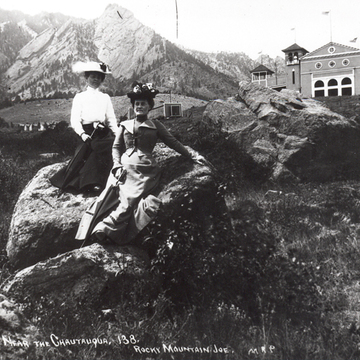Of hundreds of Chautauquas established nationwide by the 1920s, this claims to be the last one active west of the Mississippi River. Founded in 1876 on Lake Chautauqua, New York, the initial religious programs came to include educational, recreational, and political themes, as the nation's first mass education and entertainment experiment spread across the country to become a cultural institution. In 1898 a group of Texas educators agreed to arrange and fund Chautauqua programs in return for Boulder's donation of 75 acres, an auditorium, a dining hall, water, and electricity. Cottages were privately owned, and profits were put back into permanent facilities.
Today's 91-acre grounds retain the small frame cottages and lodges facing inward to create a rhythmic pattern along the streets and lanes. The standardized front and side setbacks without fences or sidewalks are in marked contrast to the tight urban residential grid to the north across Baseline Road. The original accommodations consisted of striped tents on wooden platforms, later augmented by frame cottages. The Chautauqua Community House (1918, A. E. Saunders), at the corner of Wild Rose and Morning Glory drives, is a three-story stucco hall with foundation and exterior chimney of native rubblestone. The Dining Hall (1889; 1985, OZ Architecture) is a two-story frame structure with a second-story wrap-around veranda beneath pedimented gables and towers with vernacular classical details. The rustic stone entry gate and streetcar shelter at 12th Street and Baseline Road survive in skeletal form.
The auditorium (1898, Franklin E. Kidder and Eugene R. Rice; 1983 restoration, OZ Architecture) (NR) is a pre-fabricated paneled structure that was erected in sixty days for its opening on July 4, 1898. This polygonal frame building with four observation towers framing a pedimented front typifies Chautauqua resort architecture. The main floor exterior is sheathed in vertical board-and-batten siding with Neoclassical detail. Inside is a huge, primitive, barnlike hall under a maze of exposed rafters.












